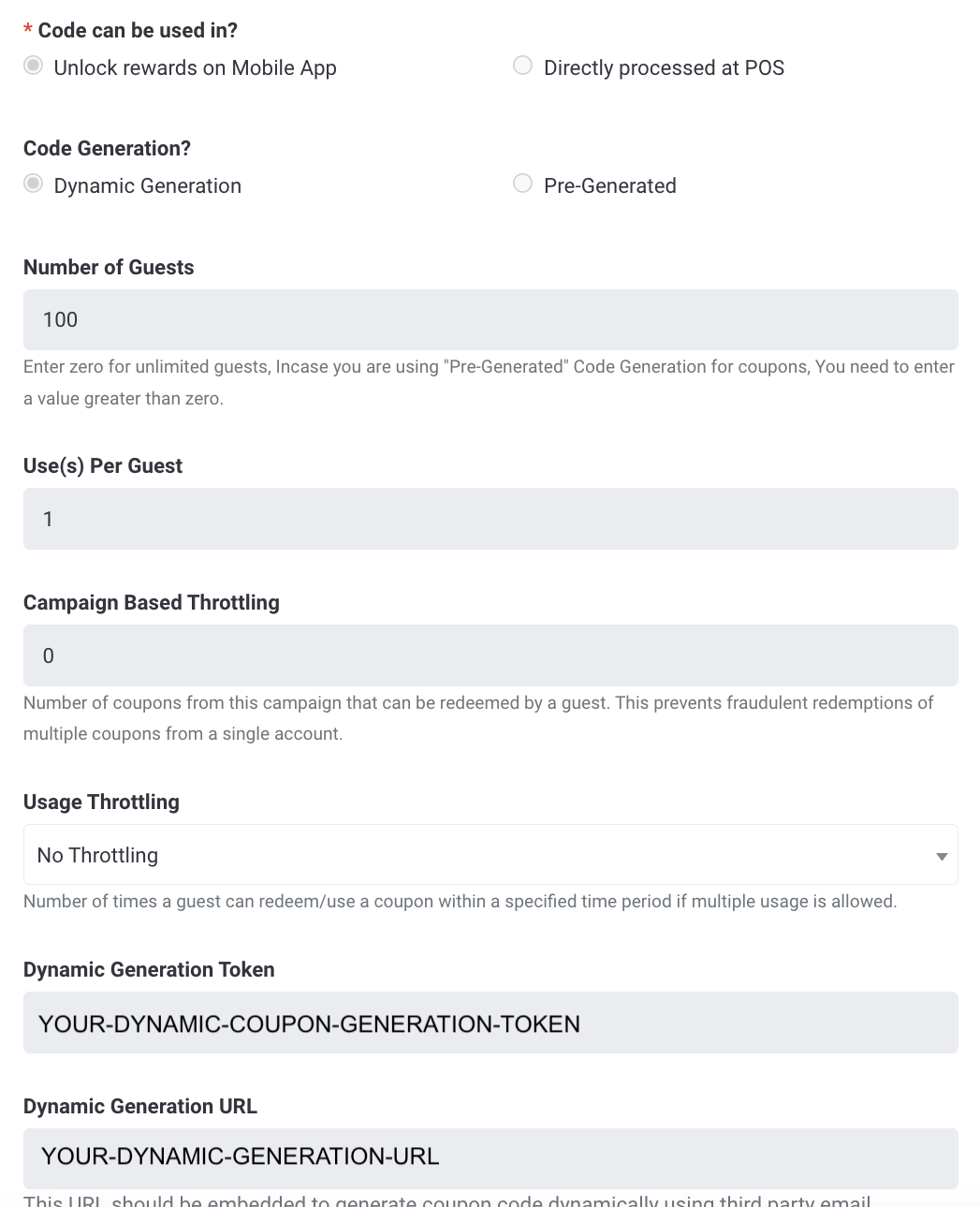Dynamic code generation
A coupon code is a unique code that can be used by a single user (either single or multiple use). The Punchh framework generates coupon codes, which can be processed within a mobile app or at the point-of-sale (POS) system.
Using the Punchh coupon framework and Braze, you can achieve the following scenarios:
- Generate a coupon code when the guest clicks a coupon generation link in an email: The coupon code will be generated dynamically and shown on a web page.
- Generate a coupon code when the guest opens an email: The coupon code will be generated dynamically and shown as an image within the email.
How to integrate Punchh dynamic coupon code generation
Step 1: Create a coupon campaign in Punchh
- Using a Punchh coupon campaign, create a dynamic generation coupon campaign as shown in the following image.
- The Punchh coupon framework will generate the following parameters to enable dynamic coupon generation:
- Dynamic coupon generation token: This is a system-generated security token for encryption.
- Dynamic coupon generation URL: This URL will be embedded in the email as a link or image, as required by the business.

Step 2: Generate signature and construct URL
The JWT.IO library decodes, verifies, and generates JSON web tokens, an open, industry-standard RFC 7519 method for representing claims securely between two parties.
The following ClaimType names can be used to ensure the uniqueness of guests and coupons:
email: represents the user’s email address.campaign_id: represents the system-generated Punchh campaign ID.first_name: captures the user’s first name.last_name: captures the user’s last name.
To use the Punchh dynamic coupon code API, a JWT Token must be constructed. Add the following Liquid template to your Braze dashboard in the message body of the channel you’d like to use:
1
2
3
4
5
6
7
8
9
10
11
12
{% capture header %}{"alg":"HS256","typ":"JWT"}{% endcapture %}
{% capture payload %}{"campaign_id":"CAMPAIGN_ID","email":"{{${email_address}}}","first_name":"{{${first_name}}}","last_name":"{{${last_name}}}"}{% endcapture %}
{% capture signature_structure %}{{header | base64_encode}}.{{payload | base64_encode | remove: '='}}{% endcapture %}
{% assign secret = "DYNAMIC_COUPON_GENERATION_TOKEN" %}
{% assign final_signature = {{signature_structure | hmac_sha256_base64: secret}} %}
{% capture jwt %}{{signature_structure}}.{{final_signature | remove: '='}}{% endcapture %}
Replace the following:
| Placeholder | Description |
|---|---|
SERVER_NAME |
The name of your server. |
DYNAMIC_COUPON_GENERATION_TOKEN |
Your dynamic coupon generation token. |
CAMPAIGN_ID |
Your campaign ID. |
Step 3: Append coupon code to message body
Link to Punchh web page
To link to a Puncch-hosted web page, add the following snippet to your message body.
1
https://SERVER_NAME.punchh.com/request_coupons/DYNAMIC_COUPON_GENERATION_TOKEN?sign={{jwt}}
Replace the following:
| Placeholder | Description |
|---|---|
SERVER_NAME |
The name of your server. |
DYNAMIC_COUPON_GENERATION_TOKEN |
Your dynamic coupon generation token. |
When a user clicks the coupon URL, they’ll be redirected to a Punchh-hosted web page, where their generated coupon will be displayed.

Extract code via JSON as plain text
To return a JSON response, add .json before the sign query parameter of the Punchh URL as shown in the following snippet:
1
https://SERVER_NAME.punchh.com/request_coupons/DYNAMIC_COUPON_GENERATION_TOKEN.json?sign={{jwt}}
Replace the following:
| Placeholder | Description |
|---|---|
SERVER_NAME |
The name of your server. |
DYNAMIC_COUPON_GENERATION_TOKEN |
Your dynamic coupon generation token. |
You could then leverage Connected Content to insert the code as plain text into any message body. For example:
1
2
{% connected_content https://SERVER_NAME.punchh.com/request_coupons/DYNAMIC_COUPON_GENERATION_TOKEN.json?sign={{jwt}} :save punchh_coupon %}
{{punchh_coupon.coupon}}
Link image inside email content
To link the coupon code inside an image, add the following snippet to your message body:
1
<img src="https://SERVER_NAME.punchh.com/request_coupons/DYNAMIC_COUPON_GENERATION_TOKEN.png?sign={{jwt}}">`
Replace the following:
| Placeholder | Description |
|---|---|
SERVER_NAME |
The name of your server. |
DYNAMIC_COUPON_GENERATION_TOKEN |
Your dynamic coupon generation token. |
Your output will be similar to the following:

Associated error messages
| Error code | Error message | Description |
|---|---|---|
coupon_code_expired |
This promo code has expired | The code is used after its configured expiration date. |
coupon_code_success |
Congratulations, Promo Code Applied Successfully. | The code is used successfully. |
coupon_code_error |
Please enter a valid promo code | The code used is invalid. |
coupon_code_type_error |
Incorrect coupon type. This coupon can only be redeemed at %{coupon_type}. |
When a code supposed to be used at the POS is used in the Mobile app, this error will occur. |
usage_exceeded |
The usage for this coupon code’s campaign is full. Please try next time. | The usage of the code exceeds the number of users allowed to use it. For example, if the dashboard configuration allows a code to be used by 3,000 users and the number of users exceeds 3,000, this error will occur. |
usage_exceeded_by_guest |
This promo code has already been processed. | The usage of the code by a user exceeds the number of times a user can use it. For example, the dashboard configuration allows a single code to be used three times by a user. If it is used more than that, this error will occur. |
already_used_by_other_guest |
This promo code has already been used by some other guest. | Another user has already used the code. |
 Edit this page on GitHub
Edit this page on GitHub